 The Clickhimin
Broch footprints on Shetland.
The Clickhimin
Broch footprints on Shetland.
Footprints at Belmont, Londonderry Road, IrelandIn northern Europe, rock footprints were closely associated with Kingship or Chieftanship. Saxo Grammaticus notes that "The ancients, when they came to choose a King, stood on stones planted in the ground to proclaim their votes, signifying from the steadfastness of the stones that the deed would be lasting". Several reputed royal footprints survive in former Pictish power-places.
Standing on a special stone is a link between the King and the land from which his people earned their food. Links with King Arthur and "The Sword in the Stone" may be relevant in this context of kingship, a right to power over his subjects and links with nature. A similar idea seems to be associated with the Moot hill or Boot Hill at Scone. for the latter name comes from an ancient tradition whereby emissaries swore fealty to their king by wearing the earth of their own lands in their foot-bindings or boots.
The upper echelons of the clergy of the Celtic Church were drawn from the nobility, indeed even some Kings retired to become monks and eventually even saints, as in the case of King Constantine of Cornwall who retired to Govan on the Clyde in Scotland. This meant that the association of stone footprints was also made with the saints, bishops and others.
The poet Spenser states that the custom amongst the Irish was to place the man who is to be chief upon a stone, always reserved for that purpose alone and located on a hill. Some of these had a footprint cut into them which was the size and shape of the candidates'. The oath was taken with the foot in the footprint, the individual swearing that as chief he would preserve all the ancient customs and respect the laws of royal inheritance.
A Locus terribilis is a sacred place into which only a divine or sacred person could enter. Petrosomatoglyph foot prints for the ordination of kings would be an example, for it was believed that only the rightful king was able to use them for the purpose that they were intended.
Footprints have been found in Sweden, Denmark, Italy, Sri Lanka (Adam's Foot), and Uganda.
 The Clickhimin
Broch footprints on Shetland.
The Clickhimin
Broch footprints on Shetland.
A crag near the chapel of Keil and St. Columba's Well, between Dunaverty Bay and Carskey in Kintyre, has two footprints carved at a place where St. Columba is reputed to have first set foot in Dalriada, Scotland. One is recent and the other genuinely old. Kingship rituals may have been connected with this petrosomatoglyph. St. Columba's footprints are to be found at Southend in Argyll. Two examples exist in Angus. On Islay there was a Stone of Inauguration by Finlaggan. It was seven feet square and had footprints cut into it. When a chief of the Clan Donald was installed as the 'King of the Isles' he stood barefoot on the imprints on the stone, and with his father's stone in his hand was anointed King by the Bishop of Argyll and seven priests. During the ceremony an orator recited a list of his ancestors and he was proclaimed 'Macdonald, high prince of the seed of Conn'. The block was deliberately destroyed in the early seventeenth century. At Spittal, near Drymen, is a footprint which may be due to natural weathering. It is located at the western end of a long ridge of natural rock outcrop. A quarry for two millstones is nearby. At Craigmaddie Muir, Baldernock, East Dumbartonshire is the 'Auld Wives Lifts'. This is a complicated assemblage of carvings on a rock-platform. On the rock are serpent-like forms, crosses, cups and an impression of the right foot of an adult. At Dunino Den (56.28° N 02.76° W NO5311), near St Andrews in Fife is a footprint and a basin carved in the surface of a sandstone outcrop. A Celtic cross has been carved nearby, possibly as an attempt to Christianise the site.
 Carved
footprint used in king-making ceremonies, Dunadd Hillfort
Carved
footprint used in king-making ceremonies, Dunadd Hillfort
 An
unclothed footprint on a boulder at Trewithen in Chapeltoun, Ayrshire
An
unclothed footprint on a boulder at Trewithen in Chapeltoun, Ayrshire
 The
footprints and associated markings from Arzon Cromlech in Morbihan, BrittanyAt
Clonmacnoise, King's County, Ireland, close to the Chapel of Clonfinlough
there are several limestone boulders, one of which is called the Fairy's
or Horseman's Stone. It has many cup-shaped hollows, croses, daggers, and
a pair of human feet. At Templemore in
The
footprints and associated markings from Arzon Cromlech in Morbihan, BrittanyAt
Clonmacnoise, King's County, Ireland, close to the Chapel of Clonfinlough
there are several limestone boulders, one of which is called the Fairy's
or Horseman's Stone. It has many cup-shaped hollows, croses, daggers, and
a pair of human feet. At Templemore in  County
Londonderry is a slab named St. Columbkille's Stone. It has the imprint
of two feet, each ten inches in length. traditionally it was the inauguration
stone of the ancient Irish chieftains. At Slievenamon (The Mountain of
the Women) at South Tipperary in Ireland is the rock that bears the footprints
of Goll - 'the One-Eyed' - who made a giant leap across the valley to catch
up with the hunt of the Fianna.
County
Londonderry is a slab named St. Columbkille's Stone. It has the imprint
of two feet, each ten inches in length. traditionally it was the inauguration
stone of the ancient Irish chieftains. At Slievenamon (The Mountain of
the Women) at South Tipperary in Ireland is the rock that bears the footprints
of Goll - 'the One-Eyed' - who made a giant leap across the valley to catch
up with the hunt of the Fianna.
An unclothed footprint on a boulder at Trewithen in Chapeltoun, Ayrshire.At Poole Farm in Somerset a cist cover was found with footprints and cupmarks. The decorated cist slab is displayed in Bristol Museum. Originally it was in position on the south side of the Pool Farm Cist, which was contained within a round barrow. Excavation revealed the cremated remains of a child and an adult. However, these carvings do have similarities with the Calderstones in Liverpool and others in Scandinavia. The footprinted "Calderstones" in Liverpool may have come from a Lancashire passage-grave. Sharkey sees a link of artistic influence between these and those at Petit-Mont in Brittany.
Located at Smithills Hall, near Bolton in Lancashire is the impressed footprint at the bottom of a set of stairs of George Marsh, a Protestant martyr. In 1555 Marsh was interrogated at Smithills Hall and then taken to Boughton in Cheshire and burnt at the stake for the sake of his faith. It is said that the footprint is a divine reminder of this unjust persecution and murder.
Often impressions of hands are made in concrete to commemorate the famous as at Grauman's Chinese Theatre in Hollywood on pavement slabs or in wet concrete. Making footprints in stone of family members is part of New Age beliefs.
Often impressions of hands are made in concrete to commemorate the famous
as at Grauman's Chinese Theatre in Hollywood on pavement slabs or in wet
concrete. Making footprints in stone of family members is part of New Age
beliefs.
 footprint
made by protestant martyr George Marsh.
footprint
made by protestant martyr George Marsh.
 In
2003, a series of footprints, now known as the Ciampate del Diavolo,
were discovered on the slopes of Roccamonfina, a dormant volcano about
35 miles from Naples. The tracks were left more than 325,000 years ago,
during an eruption. They were preserved in the ash. Locals called the prints
"devil's trails."
In
2003, a series of footprints, now known as the Ciampate del Diavolo,
were discovered on the slopes of Roccamonfina, a dormant volcano about
35 miles from Naples. The tracks were left more than 325,000 years ago,
during an eruption. They were preserved in the ash. Locals called the prints
"devil's trails."
Three primitive humans who scrambled down the volcano's slopes left their footprints fossilised in volcanic ash. One person left a track of 27 footprints in a zig-zag pattern, which probably made descent of the steep slope easier. Another track of 19 prints shows a gentle curve, but there are occasional palm-prints where the walker put a hand on the ground probably to avoid slipping. A third track of 10 evenly spaced prints forms a straight line. There are also two animal tracks, possibly made by big dogs or wolves.
The human footprints are about 20 cm long and 10 cm wide. Using the average foot length to height ratio of 15 per cent, this suggests the people who made the tracks were only about 135 cm tall (4' 5").
If the ages of the tracks are confirmed, the footprints could have been made by Homo heidelbergensis, thought to have evolved more than 600,000 years ago and migrated to Europe from Africa.
Many anthropologists believe H. heidelbergensis evolved into Neanderthals in Europe, but into modern humans, H. sapiens, in Africa. However, there is no consensus about the migration patterns of our primitive ancestors.
The Italian fossils are much younger than the oldest known hominid footprints - those near Olduvai Gorge in Tanzania are more than 3.7 million years old. They were probably made by two individuals of the distant ancestral species Australopithecus afarensis, of which the famous fossil skeleton Lucy was a member.
However, the devils' trails may be the earliest known footprints of a Homo species, which some consider to be the first true humans.
Leslie Aiello, an anthropologist at University College London, thinks the people who left the footprints seem surprisingly small for H. heidelbergensis adults.
Boxgrove man, another H. heidelbergenesis individual whose tibia was found in England in 1993, seems to have been more than 180 cm tall (six feet). The Italian footprints could have been made by children, suggests Aiello.

A set of Jesus's footprints, according to legend, are preserved at
the Church of Domine Quo Vadis outside Rome.
 It is at
this spot that Saint Peter traditionally met Jesus while the former was
fleeing persecution in Rome. According to the apocryphal Acts of Peter,
Peter asked Jesus, Domine, quo vadis? (Lord, where are you going?)
Jesus answered Eo Romam iterum crucifigi (I am going to Rome to
be crucified anew).
It is at
this spot that Saint Peter traditionally met Jesus while the former was
fleeing persecution in Rome. According to the apocryphal Acts of Peter,
Peter asked Jesus, Domine, quo vadis? (Lord, where are you going?)
Jesus answered Eo Romam iterum crucifigi (I am going to Rome to
be crucified anew).
There has been a sanctuary on the spot since the 9th century, but the current church is from 1637. The current façade was added in the 17th century.
The real name of the church, very little known, indeed, is Chiesa di Santa Maria in Palmis, where palmis refers to the soles of Jesus' feet.
 Footprints
in other parts of the World
Footprints
in other parts of the WorldA set of Jesus's footprints, according to legend, are preserved at the Church of Domine Quo Vadis outside of Rome. In Buddhist symbolism, a Buddhapada (footprint of the Buddha) with Dharmacakra and Triratna symbols from the 1st century, is to be found at Gandhâra, Northern Pakistan.
These footprints are associated with figures such as ships, shields and people.On Sri Pada, or Adam's Peak, a mountain in Sri Lanka is a footprint mark said by Buddhists to be that of the left foot of the Buddha, the right footprint being in a city about 150 kilometres distant, or at Phra Sat in Thailand. Tamil Hindus consider it to be the footprint of Shiva. Some Muslims and Christians ascribe it to Adam where Adam the 'first ancestor' is said to have set foot as he was exiled from the Garden of Eden. Sometimes Christians ascribe it to Saint Thomas, the 'Apostle of India'. Footprints of the Buddha also exist in Afghanistan, Bhutan, Cambodia, China, India, Japan, Korea, Laos, Malaysia, the Maldives, Pakistan, Singapore, and Burma. The St. Victor's Petroglyphs in Provincial Park, Saskatchewan, Canada feature human footprints.
At Llangynnlo in Wales are Olgliniau Cynllo, the knee prints of King Cynllo at prayer. At Troedraur in Dyfed, South Wales are the knee-marks of St. Gwyndaf Hen impressed on a flat rock in the bed of the River Ceri. These are 'pot holes' or rock-cut basins made by the grinding effect of stone in the river currents to the sceptics. St Cynwyl in the river at Caio in Wales. St. Beuno at Llanaelhaiarn in Wales. At Arthur's Stone chambered tomb in Hereford & Worcester is a 'cup mark' stone which bears the imprints of King Arthur's knees left behind after he prayed to God in thanks for victory over a giant (or king) whom he had killed and whose tomb this is. At Llanllyfni in Wales are the knee prints of St. Gredfyw.
John O'Donovan in his Ordnance Survey Letters of 1840 tells the story of Saint Moling crossing a small hill in the County Wexford district when an evil spirit annoyed him. He knelt on a rock to curse the spirit, leaving the impression of his knees on the stone. While there is no account of the stone today, it is said that the incident gave the name to the townsland Cloch na Mallacht, i.e. "the stones of the curses; linking the episode to bullaun stones which often contain cursing stones.

The pioneering "one small step" taken by Neil A Armstrong (38): picture
via television by Apollo lunar surface camera, black bar through center
of picture is anomaly in the Goldstone ground data system (NASA photo ID
S69-42583)
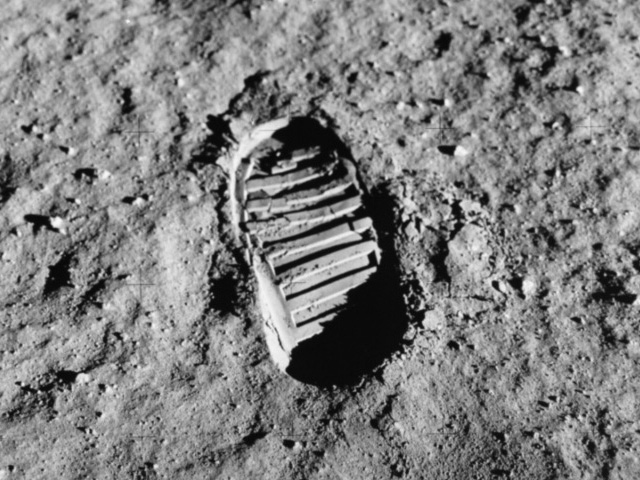
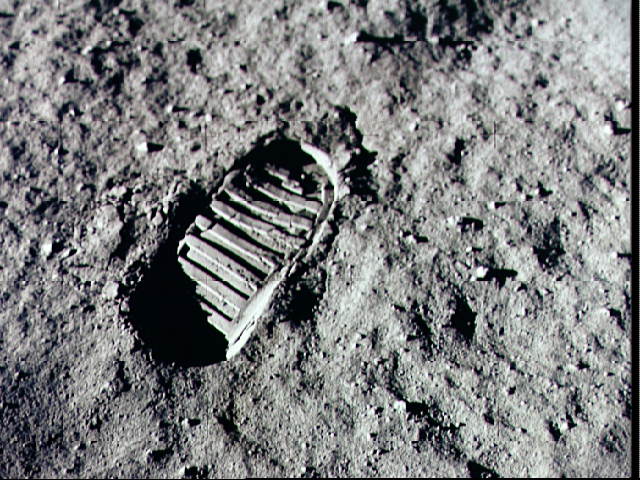
Armstrong's first footprint (70mm lens). The prints left by the astronauts in the Sea of Tranquility are more permanent than many solid structures on Earth. Barring a chance meteorite impact, these impressions in the lunar soil will probably last for millions of years. The impression, about 2.5 centimeters (1 inch) deep, demonstrates the fineness and cohesiveness of the lunar soil. (NASA photo ID AS11-40-5877&78)
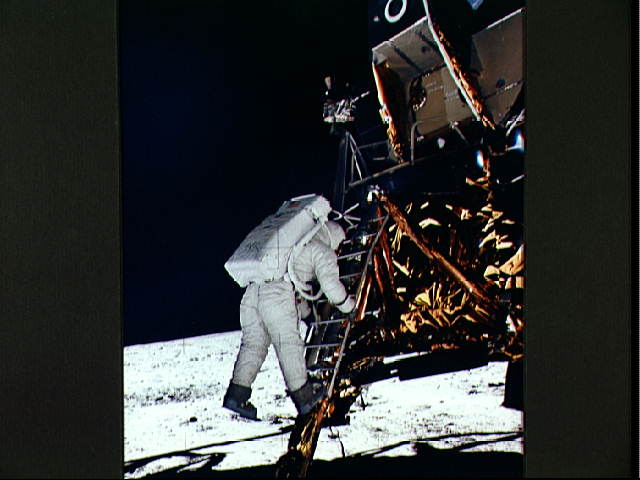
Edwin E. "Buzz" Aldrin (39) joined Armstrong on the surface less than
fifteen minutes later, in this photo taken by Armstrong. As he left the
LM, Aldrin said, "Now I want to partially close the hatch, making sure
not to lock it on my way out." "A good thought." replied Armstrong (NASA
photo ID AS11-40-5868)
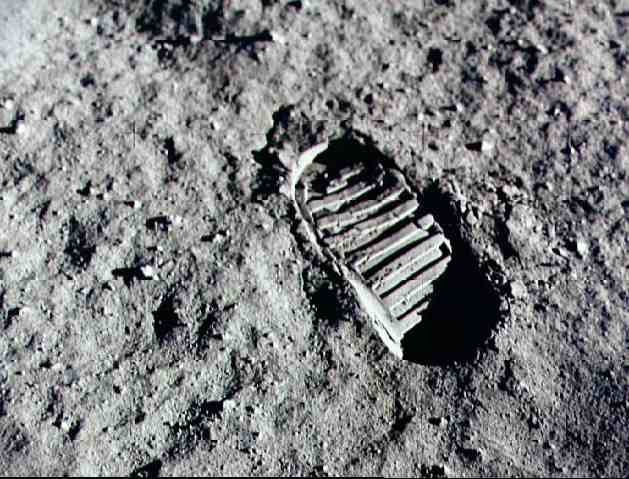
Buzz Aldrin's first footprint
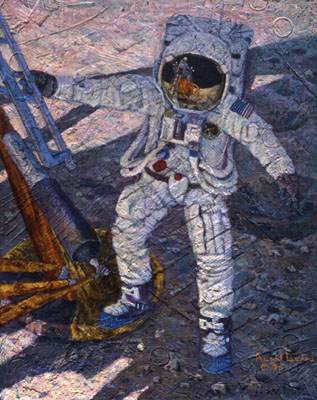 More
moonwalk audio & video
More
moonwalk audio & video
I talked with Neil for quite a while before I started this painting.
I wanted to know which rung he was holding with his right hand as he stepped
off the ladder with his
left foot, and exactly where on the landing pad was his right foot?
He paused, then asked me the same two questions about my first step some
4 months later. I told
him I didn't know. He said, "Well!" We agreed that there were some
details we just couldn't remember from our missions.
In this painting, I show Neil shifting his weight from his right foot,
which is resting on the lunar module landing pad, to his left on the Moon.
This would be considered
the first human footprint on the Moon. "...one small step for man..."
He would then shift his weight back to his right foot, still on the landing
pad, lift his left foot and
make some technical observations about the historic footprint.
As the centuries unfold, there will be first steps on Mars and other
celestial bodies. They will be much farther away than our Moon, but none
will ever be a more giant
leap for humankind than the one made by Neil Armstrong and all the
people when helped him make that leap on July 20, 1969.
Al Bean 1995, 18 x 14.25 inches, Acrylic on Aircraft Board

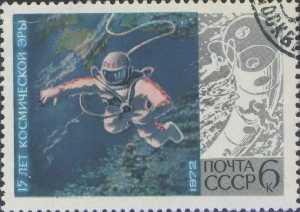
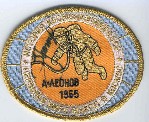
The EVA was recorded by a TV camera mounted on the reserve retrorocket
assembly and a film camera mounted on the airlock. The suit was very cumbersome,
and Leonov experienced a disorienting euphoria while outside of the vehicle.
The automatic reentry system failed and they were forced to make a manual
descent. The capsule missed the scheduled landing zone by some hundred
kilometers, creating a delay of 24 hours before the crew were reached.
 Footprints
of the Buddha
Footprints
of the Buddha
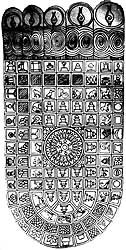 One
of the more curious aspects of Buddhism is the tradition of Buddha footprints.
Footprints are just one sign of the presence of the Buddha - the others
being the bodhi tree, an umbrella, a throne, and the dharmachakra or wheel
of the Law. Many temples have reproductions of the feet of buddha.. Tradition
holds that the Buddha (Gotama), or an incarnation known as "the future
buddha" (Metreya) left these to guide us to enlightenment. Since most of
these footprints are the size of a bath-tub, the future buddha is apparently
not someone to mess with. When found in nature, these relics are subjected
to extreme scrutiny to insure they have all of the right signs, then they
become places of worship.
One
of the more curious aspects of Buddhism is the tradition of Buddha footprints.
Footprints are just one sign of the presence of the Buddha - the others
being the bodhi tree, an umbrella, a throne, and the dharmachakra or wheel
of the Law. Many temples have reproductions of the feet of buddha.. Tradition
holds that the Buddha (Gotama), or an incarnation known as "the future
buddha" (Metreya) left these to guide us to enlightenment. Since most of
these footprints are the size of a bath-tub, the future buddha is apparently
not someone to mess with. When found in nature, these relics are subjected
to extreme scrutiny to insure they have all of the right signs, then they
become places of worship.
Footprints of the Buddha exist in Afghanistan, Bhutan, Cambodia, China, India, Japan, Korea, Laos, Malaysia, the Maldives, Pakistan, Singapore, Sri Lanka, Thailand and Burma. The first footprints appeared during the appatima period that started in the earliest period of Buddhism and which remained strong until the 4th century. In Thailand, the oldest footprint, dating to 600 AD, is located at Sar Morakot, Khok Peep District, Prachinburi province.Old versions in Pakistan, southern India and Sri Lanka have few markings.Those from the Sukhothai and Ayutthaya periods in Thailand are more decorated - at Wat Phomonastery a reclining image of the Buddha has with the soles of his feet embedded with 108 auspicious symbols. There are actually several buddha footprint temples in Thailand, but the most important of these is the Phra Puddhabat temple in Saraburi Province (20 kms. from the town of Lop Buri on the Saraburi - Lopburi route). It was discovered in 1624 and is under royal patronage of the first class, housed in a special pavillion, or mondop, which is the site of a pilgrimage fair in January-March. The footprint is a natural impression in limestone rock 50 x 150 x 30 cm deep. The brim is now covered with gold but the bottom still reveals the natural rock.The largest is the left footprint at Pakhan-gyi, Burma. During the Bagan Period (B.E.: 1583 to 1830; A.D.: 1040 to 1287), most of the several thousands of pairs of Buddha footprints were prepared, painted and embellished. There are approximately 2,000 to 3,000 pairs of stone footprints in Sri Lanka. A Buddha's footprint at the Archaeological Museum, Swat, in Pakistan is thought to be the one mentioned in the travel records of the Chinese monks Faxien and Xuanzang, who made their pilgrimages in the fifth and the seventh centuries.
In Sept.
2002, thousands of people in Thailand flocked to see a puddle
at the top of Had Sai waterfall in Pungna province, which was in the shape
of Buddha's footprint. They believe the water in the puddle will relieve
pain and bring good fortune and say it is being guarded by a frog. Many
visitors to the site left incense, flowers and candles when they came to
pray while others have being asking the frog for this month's lottery numbers.
The frog is said to be weak and close to death because many people have
been rubbing talcum powder into its skin in the hope of seeing the lottery
numbers!

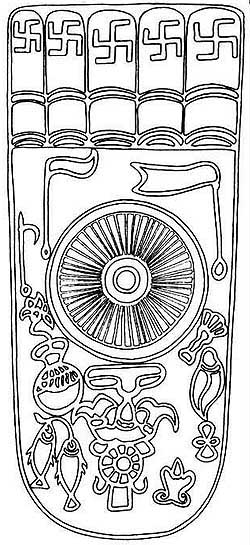
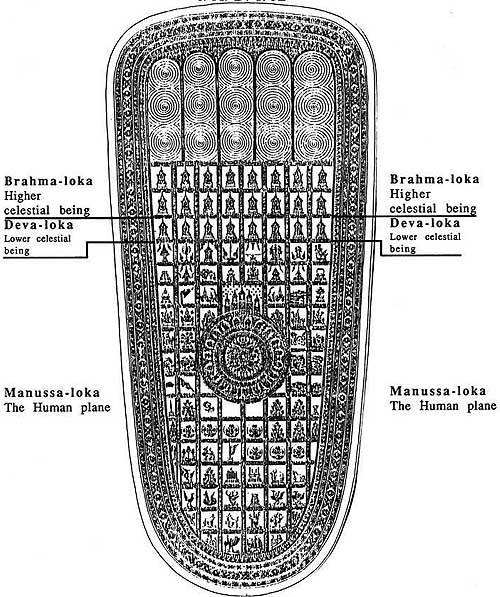



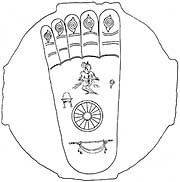

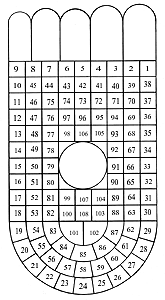
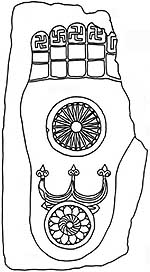
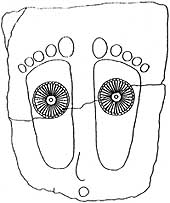

 Jutting sharply skyward
from the lush jungles of southwestern Sri Lanka is the 7362 foot (2243
meter) peak of Sri Pada, the 'Holy Footprint'. Also called Adam’s Peak,
the mountain has the unique distinction of being sacred to the followers
of four of the world's major religions: Hinduism, Buddhism, Christianity
and Islam. Long before the development of these religions, however, the
mountain was worshipped by the aboriginal inhabitants of Sri Lanka, the
Veddas. Their name for the peak was Samanala Kanda; Saman being one of
the four guardian deities of the island. For Hindus, the name of the mountain
is Sivan Adi Padham, because it was the world-creative dance of the god
Shiva that left the giant footprint (5 feet 7 inches by 2 feet 6 inches).
According to Buddhist traditions from as early as 300 BC, the real print
is actually beneath this larger marking. Imprinted on a huge sapphire,
it was left by the Buddha during the third and final of his legendary visits
to Sri Lanka. When Portuguese Christians came to the island in the 16th
century they claimed the impression to be the footprint of St. Thomas who,
according to legend, first brought Christianity to Sri Lanka. And finally,
the Arabs record it as being the solitary footprint of Adam where he stood
for a thousand years of penance on one foot. An Arab tradition tells that
when Adam was expelled from heaven, God put him on the peak to make the
shock less terrible - Ceylon being that place on earth closest to and most
like heaven.
Jutting sharply skyward
from the lush jungles of southwestern Sri Lanka is the 7362 foot (2243
meter) peak of Sri Pada, the 'Holy Footprint'. Also called Adam’s Peak,
the mountain has the unique distinction of being sacred to the followers
of four of the world's major religions: Hinduism, Buddhism, Christianity
and Islam. Long before the development of these religions, however, the
mountain was worshipped by the aboriginal inhabitants of Sri Lanka, the
Veddas. Their name for the peak was Samanala Kanda; Saman being one of
the four guardian deities of the island. For Hindus, the name of the mountain
is Sivan Adi Padham, because it was the world-creative dance of the god
Shiva that left the giant footprint (5 feet 7 inches by 2 feet 6 inches).
According to Buddhist traditions from as early as 300 BC, the real print
is actually beneath this larger marking. Imprinted on a huge sapphire,
it was left by the Buddha during the third and final of his legendary visits
to Sri Lanka. When Portuguese Christians came to the island in the 16th
century they claimed the impression to be the footprint of St. Thomas who,
according to legend, first brought Christianity to Sri Lanka. And finally,
the Arabs record it as being the solitary footprint of Adam where he stood
for a thousand years of penance on one foot. An Arab tradition tells that
when Adam was expelled from heaven, God put him on the peak to make the
shock less terrible - Ceylon being that place on earth closest to and most
like heaven.
 The mountain
is more easily seen from the sea than from land, and also more impressive.
Early Arab seafarers fascinated with the pyramidal peak wrote of it as
"the highest mountain in the world" (it is not even the highest in Sri
Lanka), and "visible from three days sail". The ancient Sinhalese also
believed it to be of great height and a native legend tells "from Seyllan
to Paradise is forty miles, and the sound of the fountains of Paradise
is heard here". Visited by many early world travelers, among them the Arab
Ibn Batuta (1304-1368) and the Venetian Marco Polo (1254-1324), Adam’s
Peak attained a legendary status as a mystic pilgrimage destination. Today
the pilgrimage season commences in December and continues until the beginning
of the monsoon rains in April (from May to October the mountain is obscurred
by clouds). Certain parts of the path leading up the mountain are extremely
steep and the climbing chains secured in these sections are said to have
been placed by Alexander the Great (365-323 BC), though there is no evidence
that he made it this far south on his Asia travels. Atop the peak is an
oblong platform (74 x 24 feet) where stands a small Buddhist temple and
the shrine of Saman with the strange footprint. Votive offerings are made
here, especially of a coil of silver as long as the donor is tall, for
recovery from sickness; and rain-water taken from the footprint is known
to have a wonderful healing power. Adam’s Peak is also called Samanalakande
or the 'butterfly mountain' because of the myriads of small butterflies
that fly from all over the island to die upon the sacred mountain.
The mountain
is more easily seen from the sea than from land, and also more impressive.
Early Arab seafarers fascinated with the pyramidal peak wrote of it as
"the highest mountain in the world" (it is not even the highest in Sri
Lanka), and "visible from three days sail". The ancient Sinhalese also
believed it to be of great height and a native legend tells "from Seyllan
to Paradise is forty miles, and the sound of the fountains of Paradise
is heard here". Visited by many early world travelers, among them the Arab
Ibn Batuta (1304-1368) and the Venetian Marco Polo (1254-1324), Adam’s
Peak attained a legendary status as a mystic pilgrimage destination. Today
the pilgrimage season commences in December and continues until the beginning
of the monsoon rains in April (from May to October the mountain is obscurred
by clouds). Certain parts of the path leading up the mountain are extremely
steep and the climbing chains secured in these sections are said to have
been placed by Alexander the Great (365-323 BC), though there is no evidence
that he made it this far south on his Asia travels. Atop the peak is an
oblong platform (74 x 24 feet) where stands a small Buddhist temple and
the shrine of Saman with the strange footprint. Votive offerings are made
here, especially of a coil of silver as long as the donor is tall, for
recovery from sickness; and rain-water taken from the footprint is known
to have a wonderful healing power. Adam’s Peak is also called Samanalakande
or the 'butterfly mountain' because of the myriads of small butterflies
that fly from all over the island to die upon the sacred mountain.

 Creationists
claim that humans and dinosaurs lived together in Texas just before Noah's
flood by citing alleged human footprints found side-by-side with those
of dinosaurs in the Cretaceous limestone of the Paluxy River near Glen
Rose, Texas. An investigation was conducted to determine if this claim
were true. Findings of this investigation are reported and discussed in
the papers included in this publication. They are: "Tracking Those Incredible
Creationists" (R. J. Hastings), an investigative chronology of the Glen
Rose creationists excavations from 1982 to the present; "Foot Notes of
an Anatomist" (L. R. Godfrey), which examines the human and dinosaur footprints
at the site; "Mantracks? The Fossils Say No!" (J. R. Cole, L. R. Godfrey,
and S. D. Schafersman); "If I Had a Hammer" and "It Ain't Necessarily So:
Giants and Biblical Literalism" (J. R. Cole). It is pointed out that the
"mantracks" (the term given by creationists to the elongated channels or
depressions found in rock) could have been formed by numerous mechanisms
other than human involvement.
Creationists
claim that humans and dinosaurs lived together in Texas just before Noah's
flood by citing alleged human footprints found side-by-side with those
of dinosaurs in the Cretaceous limestone of the Paluxy River near Glen
Rose, Texas. An investigation was conducted to determine if this claim
were true. Findings of this investigation are reported and discussed in
the papers included in this publication. They are: "Tracking Those Incredible
Creationists" (R. J. Hastings), an investigative chronology of the Glen
Rose creationists excavations from 1982 to the present; "Foot Notes of
an Anatomist" (L. R. Godfrey), which examines the human and dinosaur footprints
at the site; "Mantracks? The Fossils Say No!" (J. R. Cole, L. R. Godfrey,
and S. D. Schafersman); "If I Had a Hammer" and "It Ain't Necessarily So:
Giants and Biblical Literalism" (J. R. Cole). It is pointed out that the
"mantracks" (the term given by creationists to the elongated channels or
depressions found in rock) could have been formed by numerous mechanisms
other than human involvement.
The Paluxy River runs through Glen Rose, Texas. At the bottom of this
river, there are thousands of layers of limestone. There was a bad flood
in 1908 that ripped
off 2 feet of solid rock. This rock was carried 20 miles downstream.
This exposed thousands of dinosaur footprints. There were so many footprints
that they decided
to make the area into a State Park(Dinosaur Valley State Park). Many
of the footprints were put into museums in order to be preserved, but there
are still many there
today.
 Many human footprints
were also found. Sometimes the human tracks were next to the dinosaur tracks.
Several human footprints were found inside of the dinosaur footprints and
some dinosaur footprints were found on top of the human footprints. The
human strides were perfect.
Many human footprints
were also found. Sometimes the human tracks were next to the dinosaur tracks.
Several human footprints were found inside of the dinosaur footprints and
some dinosaur footprints were found on top of the human footprints. The
human strides were perfect.
Excavation of tracks show a compressed layer pattern underneath as one
would expect if they are genuine. A scientist who did not examine the evidence
ruled out
the possibility that the tracks were human. A professor of medicine
from the Unversity of Illinois examined the tracks and was convinced that
they were genuine
(CRSQ , 1970, 7:3, p.142; 1970, 7:4, p.246; Ryals, undated). Some years
later at least some of the supposed human tracks were definitely shown
to be dinosaur
tracks. In the past 20 years many additional discoveries have been
made to add to the controversy. Many books and articles treat these finds,
both for and against
their authenticity.

In 1930 Roland T. Bird, field explorer for the American Museum, reported
15-20 inch long "clearly defined" human footprints with dinosaur tracks.
Some skeptics believed that these human footprints were fake. They lifted
up more rock ledges along the ride of the river, only to find more prints.
One footprint was
even cut in half and sawed across the toes. The lamination line was
distorted by the mud squeezing up between the toes.
In 1970, James Ryals, who had been cutting out tracks and selling them since the 1930s, was interviewed. He reported the human tracks as mostly barefooted, but sometimes encased in some form of wrapping. The stride varied from two to seven feet. There are human tracks crossing dinosaur tracks, and dinosaur tracks which have blotted out human tracks in sequence.
Cole, John R., Ed.; Godfrey, Laurie R., Ed. The Paluxy River Footprint
Mystery--Solved. Creation/Evolution; v5 n1 Win 1985
 Before
1922 (or on 25 January 1927, according to some versions of the story),
an amateur geologist and Fortean, John T Raid or Reid (or, according to
the other version, Alfred E Knapp), found a fossil in the Triassic limestone
of Fisher Canyon, Pershing County, Nevada, as reported by W H Ballou in
the New York Sunday American of 8 October 1922. The stratum is conventionally
dated to 225 million years ago (although some give a date of 5 million
years or state that it was from coal layers 15 million years old). However,
the accounts state that it was found lying among a pile of loose rocks,
fossil side uppermost, on the side of a low hill. It showed a shoe print,
complete with a broken off heel (Knapp is quoted as saying that “it is
a layer from the heel of a shoe which had been pulled up from the balance
of the heel by suction, the rock being in a plastic state at the time”).
Before
1922 (or on 25 January 1927, according to some versions of the story),
an amateur geologist and Fortean, John T Raid or Reid (or, according to
the other version, Alfred E Knapp), found a fossil in the Triassic limestone
of Fisher Canyon, Pershing County, Nevada, as reported by W H Ballou in
the New York Sunday American of 8 October 1922. The stratum is conventionally
dated to 225 million years ago (although some give a date of 5 million
years or state that it was from coal layers 15 million years old). However,
the accounts state that it was found lying among a pile of loose rocks,
fossil side uppermost, on the side of a low hill. It showed a shoe print,
complete with a broken off heel (Knapp is quoted as saying that “it is
a layer from the heel of a shoe which had been pulled up from the balance
of the heel by suction, the rock being in a plastic state at the time”).
Microscopic photography carried out later at the Rockefeller Institute (or Foundation, according to the variant account) confirmed that it was indeed a heel and that the fossil seemed to show the presence of two rows of crewel, 8.5 mm (??) apart, with the twists in the thread clearly visible. Minute crystals of mercury sulphide confirmed the fossil’s antiquity. According to Samuel Hubbard of the Museum of Archaeology in Oakland, California, “Today’s people on the earth are not yet able to make this kind of shoe. Facing this kind of evidence indicates that at the time of suspected uncivilized arthropods, millions of years ago, people with high intelligence appear to have existed…”. The version according to which the fossil was discovered by Raid quotes him as saying that “the minutest detail of thread twist and warp, proving that the shoe sole... is strictly the handiwork of man”. It is also claimed that the right side appeared more worn than the left, indicating that it was a shoe worn on the right foot.
Even supporters of the fossil admit that most geologists who have examined the rock have concluded that it is a natural formation, even though it closely resembles a shoe print. However, the problems are even greater. Why are there two separate accounts of the same discovery, made at different dates and by different people? Why is there no agreement about the date and character of the rock in which it was found? What about the expert opinion of Samuel Hubbard? He is quoted elsewhere on this site as giving an opinion on an alleged Tyrannosaurus pictogram from Arizona. Although on that occasion, he worked as Curator of Archaeology for the Museum of Natural History in Oakland, California, this time, he works for the Museum of Archaeology. He is also quoted in 1923 as an authority for the genuineness of the Lady of the Woods in Crater National Park, saying that it might be the cast of a woman engulfed by a flow of mud that had poured down the side of Mount Mazama. The fact that it had been carved in 1917 by Dr Earl Russell Bush (and publicly acknowledged as such in 1921) does not inspire confidence in Hubbard’s investigative abilities. Moreover, another quote from him about this discovery rather gives the game away: “There are whole races of primitive men on earth today, utterly incapable of sewing that moccasin. What becomes of the Darwinian theory in the face of this evidence that there were intelligent men on earth millions of years before apes were supposed to have evolved?” This makes it clear that Hubbard was not a dispassionate investigator, but one on the side of the creationists at a time when the debate in the USA was at its fiercest.
Given the inconsistencies in the story, it is difficult to take seriously any of the claims being made for the ‘fossil’; indeed, there is little evidence that it is indeed a ‘fossil’ rather than a product of erosion. It is also troubling that there are two incompatible versions of the story, both complete with circumstantial details; one or the other has to be false, if not both (Thomas, 1971, p.24). .
In 1897, the Los Angeles Herald revealed that laborers had discovered a fossil shoe print in solid rock. The imprint was that of a shoe with a high narrow heel and a broad flat sole. It was so clear, in the fine grained shale in which it was found, that it looked as though the owner had unwittingly put his right foot into soft mud but a day or two ago. Sandal or moccasin prints have also been seen in the gypsum of the White Sands in New Mexico. Ellis Wright in 1932 found tracks of human form but 22 inches long. Some later tracks were accompanied by marks suggestive of the use of some sort of support like a walking stick by one of the antediluvian beings. The White Sands were laid down as an ancient inland sea gradually dried up around the time of the demise of the dinosaurs.
A highly detailed footprint, thought to be that of a young boy, was found fossilized in clay stone on the east bank of the Connecticut River, just south of Hadley, Massachusetts, in 1852. Also preserved in the clay were the tracks of birds, four footed animals, and snails. Even the impressions of raindrops were preserved and were not "totally obliterated by the foot of the boy. All the striae and lines on the sole of the foot appear distinctly..." Alongside the boys footprint were those of a crow, and the pattern of skin of the birds foot could be clearly seen. The bed of stone bearing these imprints line under some 20 feet of alluvial sand until it was exposed by the streams (The American Journal of Science and Arts, 2:19:391-96, May1855).
A large stone bearing the perfect imprint of a human foot 14 1/2 inches long was shown to members of the Ohio State Academy of science in 1896. The stone slab had been dug from the ground in a hill four miles north of Parkersburg, West Virginia some 20 years earlier (The American Anthropologist, February 1896, p.66).
At the summit of Big Hill in the Cumberland Mountains in Jackson County, Kentucky, is a layer of carboniferous sandstone. In the 1880's it was crossed by a wagon trail that in time broke up the surface of the rock. When the resulting debris was cleared away, a series of tracks was discovered in this carboniferous layer about 300 million years old. There were imprints of a bear, something resembling a large horse, and two "tracks of a human being, good sized, toes well spread, and very distinctly marked." The prints were examined by Professor J.F.Brown of Berea College, Kentucky (The American Antiquarian, 7:39, January 1885).
In 1938 Dr. Wilbur Burroughs, head of the geology department of Berea
College, Kentucky announced that he had discovered 10 humanoid footprints
in carboniferous sandstone on a farm belonging to Mr. O. Finnell in the
hills in the southern part of Rockcastle County. The prints were 9 1/2
inches long and 6 inches wide. The length between footprints was 18 inches.
No marks of forefeet or a tail were found. Photomicrographs and infrared
photography revealed that there were no signs of carving or artificial
markings in or around the prints. A microscopic count of sand grains indicated
that the material within the prints had been impacted, and created as the
result of a force pressing down on the firmament while it was soft. These
facts show that the prints were made by the natural result of
pressure from the human foot, and in no way could have been duplicated
by carving. The rock in which the prints were discovered was estimated
to be 250 million years old. In recent years, the prints have been destroyed
by "vandals." (Brad Steiger, Mysteries of Time and Space, pp.6-7).
A carnival of horses, bears, turkeys, and six toed humans left their tracks in what is now solid stone near the headwaters of the Tennessee River, a few miles south of Braystow, North Carolina. According to Josiah Priest, a 19th century writer on antiquities, the bizarre humanoid tracks included one of a giant - 16 inches long, 13 inches across at the toes, and 5 inches wide at the ball of the heel (Josiah Priest, American Antiquities, p.150).
A pair of human footprints once graced a slab of limestone on the west
back of the Mississippi River at St. Louis. In 1816 or 1817 the slab was
quarried from its position and removed by a Mr. George Rappe to the village
of Harmony (now New Harmony), Indiana. The prints were 10 1/2 inches long
and 4 inches wide at the toes, 6 1/4 inches apart at the heels, and 13
1/2 inches spanning between the toes, reported Henry R. Schoolcraft, "the
toes being very much spread, and the foot
flattened in a manner that happens to those who have been habituated
to go a great length of time without shoes. Notwithstanding this circumstance,
the prints are strikingly natural, exhibiting every muscular impression,
and the swell of the heels and the toes, with a precision and faithfulness
to nature, which I have not been able to copy, with perfect exactness,
in the present drawing.... Every appearance will warrant the conclusion
that these impressions were made at a time when the rock was soft enough
to receive them by pressure, and that the marks and features of the feet
are natural and genuine." In the geologic scheme of things, this limestone
hardened about 270 million years ago. Both the rock and the prints in it
were said to show the same evidence of wear and aging (The American Journal
of Science and Arts, 1:5:223-312, 1822).
On the north slope of a boulder strewn hill near the mouth of the Little Cheyenne River, South Dakota, lies the flat, dazzling white rock of magnesian limestone, which scientists say was laid down and hardened over 100 million years ago. On it are three prints of moccasined feet. In size they seem to be those of a woman or adolescent, and to judge the length of the stride (4 1/2 and 5 1/2 feet) the person who made them was running. In one of the prints, the impression made by the heel is deeper than that made by the ball of the foot, which again lends credence to the theory that whoever made the tracks was running. The depth of the tracks varies from 1/2 an inch to 1 inch. All three clearly show the instep and faint toe impressions, and all show the same amount of weathering as the unmarked surface of the surrounding stone. According to an interview which was obtained with Mr. Le Beau, who had lived in the area for over 26 years, local Indians knew nothing of the origin of the footsteps, but viewed the stone as a "medicine rock." (William R. Corliss, Ancient Man: A Handbook of Puzzling Artifacts, p.649).
Giant tracks, seemingly made by a human being, were found by a government
trapper in the Alkali
Flats area of Great White Sands, New Mexico, in 1931. A year later
a party of four, including O. Fred
Arthur, supervisor of Lincoln National Forest, set out to investigate
the tracks, with the government
trapper Ellis Wright as their guide. They found 13 imprints crossing
a relic desert basin in the eastern
most foothills of the San Andreas Mountains. Despite the great size
of the tracks, the investigators
were convinced they were human, "for the prints were perfect and even
the insteps were plainly
marked." Oval shaped, the prints are 16 to 22 inches long and 8 to
12 inches wide, with a distance
between strides of about 5 feet and a separation in width of 2 feet.
The site was revisited in 1972, 1974, and 1981, and more tracks were
found. When they were first studied, it had been noted that the imprints
were 2 1/2 inches deep. But in 1974 (42 years later) they were between
1 and 1 1/2 inches above the ground! The compacting of the soft earth by
the heavy tread of the creature had preserved the prints while the surrounding
soil had been eroded by wind and the occasional rainfall. By 1981 the tracks
stood well above the surface by several
inches. There is no doubt that the tracks were made by living creatures.
One suggestion is that they were made in the 1850's by US Army camels,
a more accepted view is that they are 10,000 years old, and were made by
an extinct animal such as a Mammoth or native camel. But the spacing of
the footprints suggests a two legged creature. The mysterious tracks are
now protected by archaeologists (U.S. Army Report, 1981).
 What
may well be the oldest fossil footprint ever discovered was found in 1968
by William J. Meister, an amateur fossil collector. If the print is what
it appears to be, the impression of a sandaled shoe crushing a trilobite,
it would have had to have been made 300 - 600 million years ago and would
be sufficient to either overturn all conventionally accepted ideas of human
and geological evolution or to prove that a shoe wearing biped from another
world had once visited this planet. Meister made his potentially disturbing
find during rock and fossil hunting trip to Antelope Spring, 43 miles west
of Delta, Utah. He was accompanied by his wife and two daughters, and by
Mr. and Mrs. Francis Shape and their two daughters. The party had already
discovered several fossil trilobites when Meister split open a rock with
his hammer and made the outrageous find. The rock fell open "like a book"
revealing " on one side the footprint of a human with trilobites right
in the footprint itself. The other half of the slab of rock showed an almost
perfect mold of the footprint and fossils. Amazingly, the human was wearing
a sandal." Trilobites were small marine invertebrates, the relatives of
todays shrimp and crabs that flourished for over 320 million years before
becoming extinct 280 million years ago. Humans are currently thought to
have begun emerging between 1 and 2 million years ago and to have been
wearing well shaped footwear for only the last several thousand. The sandal
that seems to have crushed a living trilobite was 10 3/4 inches long and
3 1/2 inches wide; the heel is indented slightly more than the sole, as
a human footprint would be. Meister took the rock to Melvin Cook, a professor
of metallurgy at the University of Utah, who advised him to show the specimen
to university geologists. When Meister was unable to find a geologist who
was willing to look at the fossil, he went to the local newspaper, The
Desert News. Before long, the find received national publicity. In a subsequent
news conference the curator of the Museum of Earth Science at the University
of Utah,
What
may well be the oldest fossil footprint ever discovered was found in 1968
by William J. Meister, an amateur fossil collector. If the print is what
it appears to be, the impression of a sandaled shoe crushing a trilobite,
it would have had to have been made 300 - 600 million years ago and would
be sufficient to either overturn all conventionally accepted ideas of human
and geological evolution or to prove that a shoe wearing biped from another
world had once visited this planet. Meister made his potentially disturbing
find during rock and fossil hunting trip to Antelope Spring, 43 miles west
of Delta, Utah. He was accompanied by his wife and two daughters, and by
Mr. and Mrs. Francis Shape and their two daughters. The party had already
discovered several fossil trilobites when Meister split open a rock with
his hammer and made the outrageous find. The rock fell open "like a book"
revealing " on one side the footprint of a human with trilobites right
in the footprint itself. The other half of the slab of rock showed an almost
perfect mold of the footprint and fossils. Amazingly, the human was wearing
a sandal." Trilobites were small marine invertebrates, the relatives of
todays shrimp and crabs that flourished for over 320 million years before
becoming extinct 280 million years ago. Humans are currently thought to
have begun emerging between 1 and 2 million years ago and to have been
wearing well shaped footwear for only the last several thousand. The sandal
that seems to have crushed a living trilobite was 10 3/4 inches long and
3 1/2 inches wide; the heel is indented slightly more than the sole, as
a human footprint would be. Meister took the rock to Melvin Cook, a professor
of metallurgy at the University of Utah, who advised him to show the specimen
to university geologists. When Meister was unable to find a geologist who
was willing to look at the fossil, he went to the local newspaper, The
Desert News. Before long, the find received national publicity. In a subsequent
news conference the curator of the Museum of Earth Science at the University
of Utah,
James Madsen said; "There were no men 600 million years ago. Neither
were their monkeys or ground sloths to make pseudo human tracks. What man
thing could have possibly have been walking around on this planet before
vertebrates even evolved?" Madsen then went on to say that the fossil
must have been formed through natural processes, though what kind he was
unable to suggest. Dr. Jesse Jennings, of the universities anthropology
department , guessed (rather boldly, considering the absence of any supporting
visual evidence) that the print might have been made by one large trilobite
coming to rest on three smaller ones. On July 20th, 1968, the Antelope
Spring site was examined by Dr. Clifford Burdick, a consulting geologist
from Tucson, Arizona, who soon found the impression of a child's foot in
a bed of shale. "The impression" he said" was about 6 inches long, with
the toes spreading, as if the child had never yet worn shoes, which compress
the toes. There does not appear to be much of an arch, and the big toe
is not prominent." The print was shown to two geologists and one paleontologist.
One of the geologist agreed that it appeared to be that of a human being,
but he paleontologist said that no biological agent had been involved.
Dr. Burdick stuck to his guns: "The rock chanced to fracture along the
front of the toes before the fossil footprint was found. On cross section
the fabric of the rock stands out in fine laminations, or bedding planes.
Where the toes pressed into the soft material, the laminations were bowed
downward from the horizontal, indicating a weight that had been pressed
into the mud." In August 1968 Mr. Dean Bitter, an educator in the Salt
Lake City public school system, claimed to have found two more footprints
in the Antelope Springs area. According to Dr. Cook, no trilobites were
injured in these footfalls, but a small trilobite was found near the prints
in the same rock, indicating that the small sea creature and the sandaled
traveler might have been contemporaries (Bible Science Newsletter, August-September
1969, Royal Research Society Quarterly, December 1968; CRSQ, 1968, 5:3,
p.97).
 In
1882 huge footprints, strongly resembling those of a human wearing shoes,
were found in a layer of sandstone in the yard of the state prison near
Carson City, Nevada, during digging operations. The prints were between
18 and 20 inches long and approximately 8 inches wide. The stride was about
3 feet and the distance between the left and right tracks, the straddle,
was about 19 inches. Numerous other tracks resembling those of deer, horses,
elephants and wolves were found in the same layer of sandstone. Since the
size of the prints and the age of the rock at the layer they were discovered
(2 to 3 million years old) argued against a human or even a hominid origin,
the prints were ascribed to a more acceptable origin, the tracks of a giant
ground sloth. It is thought that these animals could stand upright, but
only by using their tails for additional support. However, no tail track
was found at this site. It was also suggested that perhaps the animal was
walking on four feet, and that its rear legs were landing exactly in the
tracks left by its front feet, thereby creating the impression of a biped.
But this fails to account for the fact that the tracks show no toe marks
(The American Journal of Science 3:26:139-40, July-December 1883).
In
1882 huge footprints, strongly resembling those of a human wearing shoes,
were found in a layer of sandstone in the yard of the state prison near
Carson City, Nevada, during digging operations. The prints were between
18 and 20 inches long and approximately 8 inches wide. The stride was about
3 feet and the distance between the left and right tracks, the straddle,
was about 19 inches. Numerous other tracks resembling those of deer, horses,
elephants and wolves were found in the same layer of sandstone. Since the
size of the prints and the age of the rock at the layer they were discovered
(2 to 3 million years old) argued against a human or even a hominid origin,
the prints were ascribed to a more acceptable origin, the tracks of a giant
ground sloth. It is thought that these animals could stand upright, but
only by using their tails for additional support. However, no tail track
was found at this site. It was also suggested that perhaps the animal was
walking on four feet, and that its rear legs were landing exactly in the
tracks left by its front feet, thereby creating the impression of a biped.
But this fails to account for the fact that the tracks show no toe marks
(The American Journal of Science 3:26:139-40, July-December 1883).
The footprint of a human being, apparently fleeing toward the Gediz River from a volcanic eruption, was discovered in volcanic ash during the construction of a dam near Demirkopru, Turkey, in 1970. The age of the ash was determined to be 250,000 years old by the Turkish Mineral Research and Exploration Institute in Ankara, and the print was pronounced human by the National Laboratory of Forensic Science in Sweden. If so, whoever made the print was an antecedent of Neanderthal man (Nature, 254:553, April 17th, 1975).
In the American Journal of Science a number of references to footprints
in rock strata are discussed and reproduced, such as the following: Human
impressions
were reported in various locations in South America, but details are
lacking...Human footprints in a limestone slab in a paved area between
a house and garden in
New Harmony, Indiana...A rock outcrop extending for three miles in
front of St. Louis, Missouri, one to 200 feet wide, was observed during
low water stages. The
large number of human footprints there were noted already by early
French explorers. The prints are in crinoidal limestone. The prints are
described as of a man
standing erect with toes spread apart. They appeared strikingly natural
with every muscular impression, and the swell of heel and toes. The print
described was about
10 1/2 inches long. The observer contrasted these prints with obviously
carved footprints he had observed elsewhere...Other prints were reported
in a quarry at
Herculaneum, Missouri, and on rocks near Kingston, New York (CRSQ ,
1970, 7:4, p.205).
 The
State Geologist of Kentucky performed extensive tests on footprints found
near Berea. The prints were discovered when the overburden from a sandstone
formation was removed in logging operations about 1930. One series of prints
found included some arranged in a normal walking stride. Microscopic studies
showed that the grain counts were greater in the soles than in the adjacent
sandstone, showing greater compression within the print areas. Distinct
left and right foot impressions were found, each with five toes and with
a distinct arch. The prints could not have been carved since some of the
tracks were
The
State Geologist of Kentucky performed extensive tests on footprints found
near Berea. The prints were discovered when the overburden from a sandstone
formation was removed in logging operations about 1930. One series of prints
found included some arranged in a normal walking stride. Microscopic studies
showed that the grain counts were greater in the soles than in the adjacent
sandstone, showing greater compression within the print areas. Distinct
left and right foot impressions were found, each with five toes and with
a distinct arch. The prints could not have been carved since some of the
tracks were
still partly covered by higher sandstone strata. Other prints have
been reported in nearby areas, but further information is lacking (CRSQ
, 1970, 7:4, p.207).

Close by a lake near Managua, Nicaragua are perhaps the most famous
footprints in the Americas. They lie under eleven strata of solid rock
from 16-24 feet under the surface. Heated debate about the age of the prints
has gone on for almost a century. Initially they were dated about 200,000
years old, but since the
feet were perfectly modern the age was reduced to older than
50,000 years. The only geologist to visit the scene at the initial discovery
also found traces of domesticated dogs and horses with the prints - an
impossible situation to resolve.

Polished stone artifacts and projectile points were also discovered.
The prints are now dated at about 3000 B.C. on the basis of C14 tests,
but this forces a considerable number of catastrophic events in a very
short time period. Since various fossilized animal bones and mastodon remains
have been found in strata above the human prints, the conclusion then is
forced that the mastodon lived into very recent times. Near the city of
San Raphael other human and animal tracks were found, including a sandal
print which is now in the museum at Harvard (Victoria Institute , 1886,
22:148-152; Archaeology , 26 [April 1973], 146-147).

In the park, the visitor can follow the steps of his last walk. From the door of the plain, white painted room with a glass veranda where he lived there are cement footprints across the park to where he was murdered. Here the visitors go barefoot and silent.
